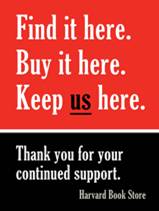Buying It: Turning the Scan Into a Sale
Dealing with customers who are obviously browsing the store to buy elsewhere can be tricky. To steer them toward the cash wrap instead of the door, Harvard Book Store has created a video and signage, Tattered Cover posts fliers with QR codes, and Aaron’s Books handsells the Shop Local message.
Lynne Almeida of Spellbinder Books & Coffee of Bishop, California, has been struggling with the best way to talk with people who are “shopping at the store with their little devices out. Even if you can find it in yourself to calmly approach them,” she said, “they often say they’re just making a list for when they get their next paycheck. It’s really hard to engage them.”
She has brainstormed ways to stop leakage, but hasn’t developed “a really good script in a concise manner.”
Almeida posted her question on BookWeb’s Bookseller-to-Bookseller forum: “Does anyone have any clever/humorous/pointed-yet-not-too-offensive/negative signage ideas that address this issue?”
Another bookseller pointed Almeida toward Harvard Book Store’s approach. Carole Horne, Harvard’s general manager, told BTW, “There are two things we’ve done: a video that’s on our website, and that we included in one of our e-newsletters, called ‘Don’t Be an iPhoney.’
 “We also have this large sign in the store and a smaller copy on the door: ‘Find it here. Buy it here. Keep us here.’” Harvard Book Store also includes the “Find it here” message on the bottom of their weekly newsletter. “We do get customer comments, mostly supportive, and we encourage booksellers to have conversations with customers who bring it up,” said Horne.
“We also have this large sign in the store and a smaller copy on the door: ‘Find it here. Buy it here. Keep us here.’” Harvard Book Store also includes the “Find it here” message on the bottom of their weekly newsletter. “We do get customer comments, mostly supportive, and we encourage booksellers to have conversations with customers who bring it up,” said Horne.
“To the question ‘Does this [sign] mean you’re in trouble/going out of business?’ our answer is ‘No, we’re fine, but we’d like our customers to think about the issue before we’re in trouble, because then it’s too late.’” (Booksellers are free to link to the iPhoney video, or to create their own, but Horne asks booksellers who would like to use the “Find it here. Buy it here. Keep us here.” sign to contact the store.)
As far as the smartphone-wielding customers, Horne said, “I wish we’d figured out how to respond to people in the store that we see scanning bar codes, etc., but we haven’t.”
In Denver, Tattered Cover’s answer is to post fliers with their own scannable codes that link to the Tattered Cover website. “We have QR codes all over the stores to say, ‘Hint hint, do your buying here.’ but so far don’t have official signs or policies,” said lead book buyer Cathy Langer.
Posting the signs causes less confrontation and possibly less confusion. “I did approach a customer once (a 20-something guy) who seemed to be doing something with his phone,” said Langer. “When I asked him if he was buying online he said no, he was texting his girlfriend for help in picking something out as a gift for her father. I was rather embarrassed and then proceeded to help him, and he was grateful and bought a couple of books on CD. He hadn’t realized that he needed me more than his girlfriend and that’s why you come to a real live store!”
Todd Dickinson of Aaron’s Books in Lititz, Pennsylvania, just tackles the subject if he overhears a customer say something about buying elsewhere. “We just try to do it in a conversational way,” he said. “Although there are plenty of things I’d like to say, we talk about that if you’re holding a book in your hand, you can have it immediately. And we talk about Shop Local, a message we try to include in most of our communications about the importance of independent bookstores.”